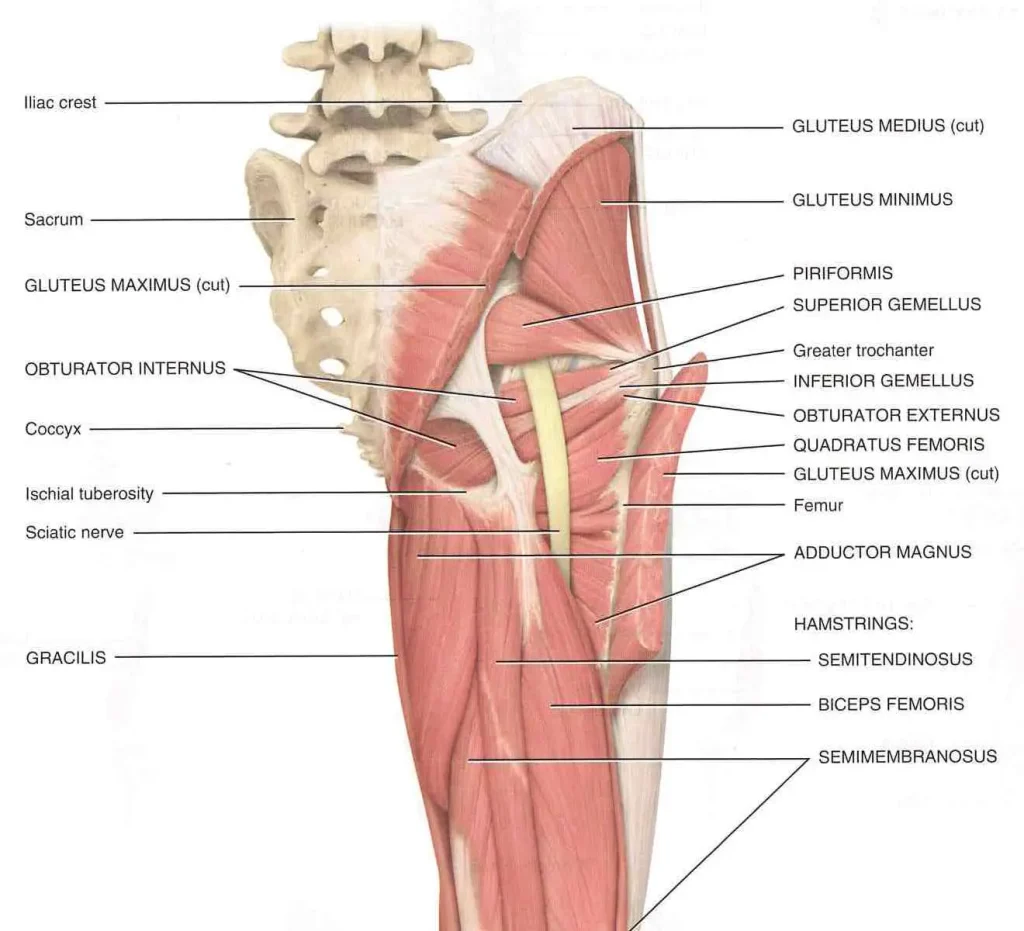Piriformis syndrome is a neuromuscular condition caused by the piriformis muscle compressing the sciatic nerve. This small, pear-shaped muscle, located deep in the buttocks, plays a crucial role in hip movement and stability. When it becomes tight, inflamed, or injured, it can lead to significant discomfort and mobility issues.
What is Piriformis Syndrome?
Piriformis syndrome occurs when the piriformis muscle irritates or compresses the sciatic nerve, causing pain, tingling, or numbness along the nerve’s pathway, which extends from the lower back through the buttocks and down the legs.
Common Causes
Several factors can contribute to piriformis syndrome, including:
- Anatomical Variations: In approximately 17% of people, the sciatic nerve runs through the piriformis muscle, increasing the likelihood of compression.
- Overuse or Strain: Running, cycling, or prolonged sitting can overwork the piriformis, leading to spasms or hypertrophy (muscle enlargement)

3. Trauma: Direct trauma to the buttock area, such as from a fall or car accident, can cause inflammation, scarring, or tension in the muscle.
4. Poor Posture: Sitting with poor posture for extended periods can contribute to muscle tightness and nerve irritation.
Recognizing the Symptoms
Piriformis syndrome can manifest with a range of symptoms, including:
- Persistent pain or tenderness in the buttocks.
- Radiating pain down the back of the leg, often mistaken for sciatica.
- Tingling, numbness, or burning sensations in the affected leg.
- Difficulty sitting comfortably for extended periods.
- Limited range of motion in the hips or stiffness when walking.
If these symptoms sound familiar, it’s essential to seek professional guidance to determine the best course of action.
Effective Treatments for Piriformis Syndrome
Managing piriformis syndrome involves stretching, strengthening, and professional therapies to reduce muscle tension and alleviate nerve compression.
- Stretching Exercises Continued assisted stretching of the piriformis muscle can help release tension. Some effective stretches include:
- Figure-4 Stretch: Cross one leg over the opposite knee and gently pull toward your chest.
- Seated Piriformis Stretch: Sit upright, cross one leg over the other, and twist your torso toward the raised knee.
- Corrective Exercises Strengthening the surrounding muscles, like the glutes and hips, helps to stabilize the pelvis and reduce stress on the piriformis.
- Massage and Manual Therapy Soft tissue mobilization techniques, such as trigger point therapy, can target and release muscle tightness.
- Professional Stretch Therapy At Utah Stretch and Flexibility, we specialize in assisted stretching programs tailored to relieve piriformis syndrome. Our team helps clients achieve greater mobility and flexibility while addressing pain at its root.
- Lifestyle Adjustments Simple changes, like standing more often, using ergonomic seating, and practicing good posture, can reduce strain on the piriformis muscle.
- Medical Interventions In severe cases, anti-inflammatory medications, corticosteroid injections, or even surgery may be recommended. Always consult a healthcare provider before pursuing these options.
Preventing Piriformis Syndrome
Prevention is key to avoiding the discomfort and limitations of piriformis syndrome. Here are a few tips:
- Incorporate daily stretches targeting the hips and lower back.
- Warm up before intense physical activities.
- Strengthen core and hip muscles to provide better support.
- Avoid prolonged sitting or invest in an ergonomic workstation.
- Listen to your body—stop and rest if you feel discomfort during activities.
Piriformis syndrome may be a common condition, but with proper care, you can overcome its challenges and regain comfort in your daily activities. Stretching, strengthening, and seeking professional help are powerful tools in managing and preventing this condition. At Utah Stretch and Flexibility, we’re here to guide you every step of the way.
For additional resources, check out this Wikipedia article on Piriformis Syndrome.
